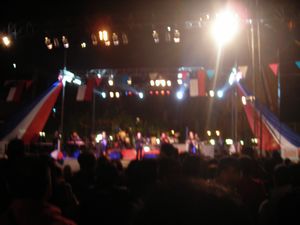Advertisement
Published: September 20th 2010

 DSCN3414
DSCN3414
Celebration of the Bicentenario in Plaza Cristobal ColonThe 18th of September is Chile's independence celebration, and I am lucky enough to be here for the 200th anniversary. The Bicentenario demands a 4 day weekend, with Friday and Monday off, lots of food, friends, family, cueca, and vino! The Chileans are super patriotic and wear their traditional clothes to dance the cueca all day long. It is a highly choreographed dance of flirtation, but you still see college students dancing with their grandmothers and parents and children cueca-ing all over. In the center of town, at Plaza Colon and nearby, there have been concerts, dances, games, street entertainers, and a market all weekend long.
My participation in Bicentenario events involved seeing my host sister, Javiera, and her entire colegio perform traditional Chilean dances on Wednesday. On Thursday I learned the cueca in my Spanish class and afterwards we had a party with lunch and presents. I got a hat and a llama, which I am pretty excited about. I went on Friday night to see a band whose name I never caught, visit the market, and watch the fireworks off the top of the Morro at midnight. In the market I picked up a bonano (fannypack). You can
laugh all you want, but it is very handy for stashing a phone, camera, and some cash when you go out, and it is hard to lose when it is around your waist! Also, they are very popular here. Chilean fashion is different from the US in a couple of ways. Hairstyles for college-age boys often include 2-6 dreadlocks on the back of their head or mullet-like elements. All of the girls wear their hair long, but older women tend to have short hair. There are also a lot of people with facial piercings and tattoos, which I thought was surprising for a country I have often been told was "conservative." As for the clothes, a significant amount are second-hand from the US which is something I have seen in other countries (Ghana, Thailand, Dominican Republic), but didn't expect here. But that is all a side note.
On Saturday my host family and I went to Club de Huaso, which is a campground in Azapa. We had a lunch- some photos of the food follow this entry- and afterwards watched a rodeo. The rodeo sports here are different then those we see in the US, though they still
involve cows, horses, and cowboys. Rodeo is a actually a national sport in Chile and riders always wear the traditional huaso get-up. This involves a poncho, knee high boots with tassels, and giant spurs with multiple spikes that I, as a person involved with horses, find sort of terrifying. The sport involves two riders chasing a calf around the media-luna and trying to pin the cow against the wall before it can run in a full circle. The riders sandwich the calf and run it along the outside of the media-luna and the the rider on the inside pins the calf against a padded section of the wall. I don't think the calves enjoy it very much, and one of them jumped a 6+ ft fence to try to escape. Really impressive, and answers the question of whether or not cows can jump. Afterwards there were some bucking broncos. I didn't think they looked too challenging, but I like to keep my brains inside my skull so I refrained when they asked for volunteers.
Today my host family held an Asado, which means that they grill a lot of meat and invite tons of relatives over for the almuerza.

 Asado
Asado
Grilled chicken, chorizo, and steak.The food was delicious, and I have obviously turned omnivore in Chile. It has not been hard, and I don't want to miss out on trying the local cuisine. Unfortunately I think, for the most part, that the meat manufacturing system is fairly similar to that of the US, which is a large part of why I was vegetarian in the past. Obviously all the mariscos (seafood) here are fresh from the Pacific, though! Lunch was delicious, and I was able to meet many of my host families relatives. My tío has dubbed me "Lady Washington," and both family almuerzas I went to this weekend were punctuated by him toasting me or asking me to dance the cueca. The family has been friendly and put up with my mangling of castellano (the word for españole in these parts). So that was the Bicentenario in Chile. I have one more day off from school, and then it is off to Putre in the interior/altiplano region for 3 days of education on Aymara culture and traditional and rural medicine!
I caught a cold this weekend, and I have to note that being abroad when you are sick is one of the

 Picante de Papas
Picante de Papas
Actually a recipe from Peru, and here with Azapa olives.worst things I have experienced. Thank god for host families!! Cecelia keeps telling me to wear my bufonda and drink lots of water. Of course, it is definitely not as good as having my mom here to take care of me but we have a location issue with that. And I'm not too sick, just a sore throat. Nothing nearly as bad as the time I got food poisoning in Ghana and the doctor told me I had malaria. While I was laying in bed every woman from my neighborhood came by and said "Nyere, Abena" or "Don't be sick, Abena." Hopefully I will be healthier by Tuesday for my trip to Putre.
Advertisement
Tot: 0.16s; Tpl: 0.041s; cc: 10; qc: 50; dbt: 0.0944s; 1; m:domysql w:travelblog (10.17.0.13); sld: 1;
; mem: 1.1mb










